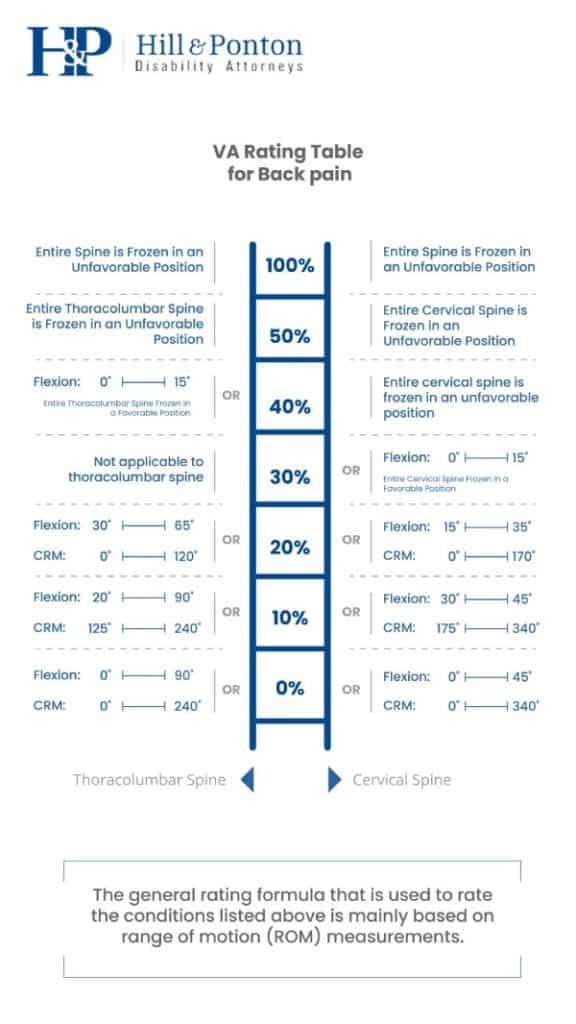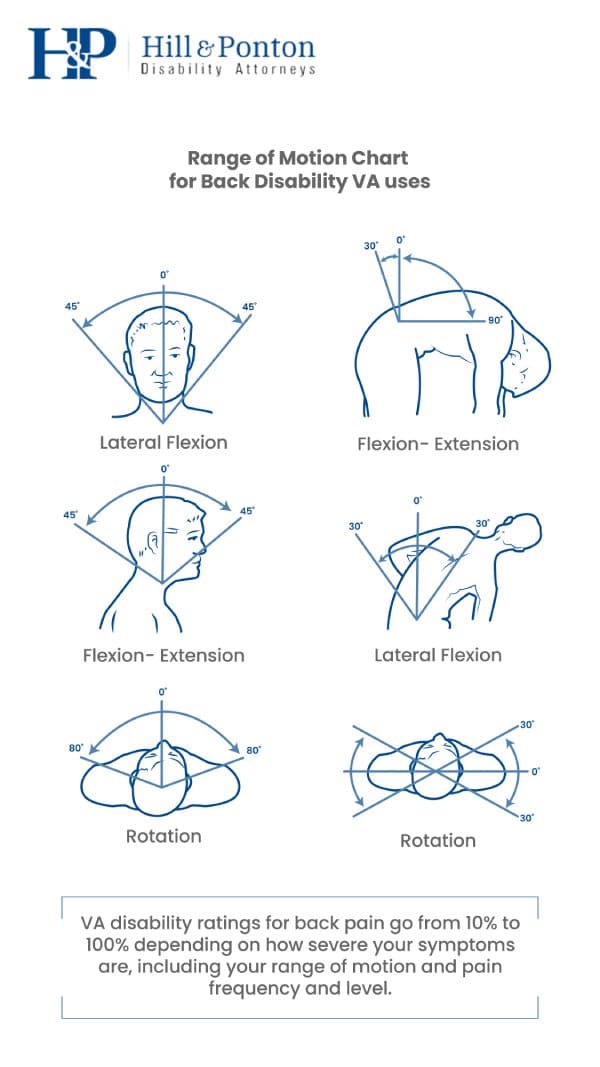Did you know, according to the Veterans Administration (VA) almost 13 million veterans are service connected for orthopedic conditions? Almost 11 million of those veterans are men alone! There are many different musculoskeletal conditions veterans can be service connected for, back pain being one of the most common.
If you experienced a back injury during active duty, or an injury that later contributed to back pain, you may be eligible for disability benefits.
As with most medical conditions, the VA disability rating for spinal conditions depends on a variety of factors. This guide will break down how the VA rates back pain and spinal disabilities, so that you can make a successful claim.
How does the VA rate back pain?
The evaluation of back pain for VA disability benefits is intricately linked to the impact this pain has on your overall physical wellbeing and your capacity to engage in daily activities.
The VA meticulously assesses how your back pain restricts your movement and interacts with your day-to-day life, utilizing a detailed ratings system, specifically for musculoskeletal disabilities.
The VA’s ratings schedule introduces concepts of “favorable” and “unfavorable” ankylosis to describe the mobility or immobility of the spine. In simpler terms, “ankylosis” refers to the extent of movement your spine can achieve.
A “favorable” designation means your spine maintains a straight posture, whereas “unfavorable” ankylosis indicates a spine that is fixed in a bent position, severely limiting mobility.
The VA Ratings Table for Back Pain and Range of Motion (ROM) Chart


Imagine sitting down with a VA medical examiner to discuss your back and neck pain.
The examiner explains that they assess two primary areas:
- the thoracolumbar spine (the larger part of your back)
- the cervical spine (your neck)
Each area is evaluated separately to determine its impact on your mobility and daily life. Below are examples of how a medical examiner might explain why you’d get a certain rating.
VA Ratings for Thoracolumbar Spine Injuries
- 50% Rating: Envision your back being immobilized in an uncomfortable position, significantly restricting your ability to move freely.
- 40% Rating: Your back may be fixed, but in a slightly more tolerable position. You might also have minimal forward bending capability, no more than the length of a standard ruler.
- 20% Rating: You’re able to bend forward a bit more, between the length of a ruler and roughly the span of two hands. This rating applies if your back’s overall mobility is notably limited.
- 10% Rating: There’s a degree of flexibility in your back, allowing for forward movement up to about three hand lengths. This is the rating for moderate range of motion limitations.
VA Ratings for Cervical Spine Injuries
- 40% Rating: Your neck is stuck in an uncomfortable, fixed position. Combined with a similar condition in your back, this could justify a full 100% disability rating.
- 30% Rating: While your neck might be fixed, it’s in a less restrictive position, or you might manage a slight forward tilt.
- 20% Rating: You can tilt your head forward a little, up to about the width of your hand. This rating reflects significant restrictions in neck mobility.
- 10% Rating: Your neck allows for more movement, enough to tilt your head forward the width of a hand to a hand and a half. This rating is assigned for moderate movement limitations.
VA Ratings for Intervertebral Disc Syndrome (IVDS)
Intervertebral Disc Syndrome (IVDS) involves the degeneration or damage of spinal cushioning discs, potentially leading to herniation, sciatica, and chronic pain, often worsened by sitting, bending, or lifting. The VA evaluates IVDS severity through disability ratings, which hinge on the frequency and severity of incapacitating episodes requiring medical intervention.
- 60% Rating: Assigned when you’ve encountered incapacitating episodes totaling six weeks or more within the last year. Picture being sidelined, unable to engage in your regular daily activities for at least a month and a half over the past year due to severe back issues.
- 40% Rating: This rating is for those experiencing episodes that last at least four weeks but don’t surpass six weeks throughout the last 12 months. It reflects significant but slightly less frequent disruptions to your life due to IVDS.
- 20% Rating: Given for episodes lasting two to four weeks over the past year, indicating a moderate impact of IVDS on your daily functionality and well-being.
- 10% Rating: The initial rating for episodes that have lasted at least a week but less than two weeks within the last year, pointing to occasional but notable interruptions caused by IVDS flare-ups.
Master the VA Disability Claims Process
What is Range of Motion (ROM) and why is it important for spinal injury VA ratings?
Range of Motion (ROM) is central when it comes to assessing your VA disability rating for back and neck pain.
Remember, measuring ROM is crucial for two main areas (as mentioned above):
- Cervical Spine (Neck)
- Thoracolumbar Spine (Lower Back)
Why is ROM so important? It directly reflects the flexibility and functional capacity of your spine, impacting your disability rating.
The Goniometer is a specialized tool essential for ROM measurements. Ensure your examiner is proficient in using this tool!
The accuracy of these measurements is critical. Without correct goniometer use, the VA may disregard the results in their evaluation.
Positioning Matters! The examiner also checks if your spine is fixed in a particular position. A straight spine is “favorable,” while any deviation is “unfavorable.”
Remember: Your disability rating hinges on precise ROM measurements and the correct application of the goniometer. It’s vital that the medical examiner knows how to use this tool effectively to ensure your rating accurately mirrors your condition.
What is the average VA disability rating for back pain?
The average VA disability rating for back pain is between 10–30%, typically falling around 20%.
This is because many veterans experience a range of motion limitations and pain that are significant enough to warrant a rating higher than 10% but not severe enough to meet the criteria for higher ratings like 40% or 50%.
For conditions like lumbosacral or cervical strain, degenerative disc disease, or intervertebral disc syndrome, the 20% rating is often the most common because it reflects moderate impairment and limitations in the range of motion, which are frequently encountered by veterans with these conditions.
How do I get 100% for back pain?
There are a few different options to get to a 100% VA disability rating for back pain. To obtain a 100% VA disability rating for back pain on its own, there must be a total immobilization of the spine, where both the thoracolumbar (lower/middle back) and cervical (neck) areas show no mobility.
For a full 100% rating, your spine must be completely immobile or “frozen” in an unfavorable position (bent or curved), which denotes a severe level of disability.
If you’re like many veterans, however, you may have a debilitating spinal injury but not be completely immobile, but there are still a few options for you to consider — either connecting your back pain to a secondary condition or, if you are unable to maintain substantially gainful employment, TDIU may be an option.
Maximize Your Benefits
Unhappy with your VA decision? We’re here to help. Contact us for a free review of your case.
Connecting Secondary Conditions to Spinal Injuries
Back pain often triggers additional health issues, which may contribute to a higher combined disability rating.
Often veterans connect multiple conditions, so consider how your back pain may impact other aspects of your life and well-being.
Here’s a list of secondary conditions commonly linked to back pain for you to consider:
- Radiculopathy: Characterized by nerve pain, numbness, or tingling that radiates from the spine to the extremities. Depending on the affected area, it can manifest as sciatic nerve pain in the legs (from lower back issues) or arm pain (from neck issues).
- Degenerative Disc Disease (DDD): A condition where spinal discs wear down, leading to pain, instability, and reduced mobility. DDD can exacerbate or be exacerbated by spinal injuries.
- Osteoarthritis: Joint pain and stiffness resulting from the degeneration of cartilage, which can be secondary to changes in posture and walking due to spinal injuries.
- Spinal Stenosis: Narrowing of the spinal canal, often leading to nerve pain and mobility issues. This can be a direct consequence of spinal injuries or degenerative changes over time.
- Spondylolisthesis: A condition where one vertebra slips forward over another, often resulting from injury or degeneration, leading to back pain, numbness, or weakness.
- Ankylosing Spondylitis: A form of arthritis that primarily affects the spine, leading to severe inflammation, pain, and stiffness. Over time, it can cause the vertebrae to fuse together, significantly limiting motion.
- Traumatic Paralysis: Paralysis resulting from a traumatic injury to the spinal cord, leading to partial or complete loss of muscle function and sensation below the level of injury. This condition significantly impacts daily living and may require comprehensive medical and support services.
- Chronic Pain Syndrome: Persistent pain that can develop following spinal injuries, affecting physical and mental health.
- Depression and Anxiety: Mental health conditions that can arise due to chronic pain, reduced mobility, and the lifestyle changes that spinal injuries often necessitate.
- Impaired Mobility: Limitations in movement and activities of daily living due to pain, stiffness, or loss of function in the spine.
- Orthopedic Problems in Knees and Hips: Issues arising from altered walking patterns due to spinal injuries or conditions, which can lead to additional strain and injuries in the knees and hips.
- Fractures or Dislocations in the Spine: These injuries can cause immediate and chronic pain and mobility issues, complicating the spinal condition and potentially leading to further spinal instability or nerve damage.
- Urinary or Bowel Incontinence: Nerve damage from spinal injuries can lead to issues with bladder or bowel control.
- Sexual Dysfunction: Spinal injuries can affect sexual health and function due to nerve damage or psychological stress related to the injury and its implications.
Remember, the above list is not exhaustive, and there may be other connections you can make.
Why Worry About All the VA’s Complicated Tables When We’ve Done the Work for You?
Navigating the VA’s complex disability rating tables to figure out multiple ratings can be overwhelming and confusing. That’s where our VA Disability Calculator comes in – a tool specifically designed to save you time and effort!
With just a few clicks, you can gain insights into:
- Your Expected Disability Rating: No more guessing or trying to interpret complicated tables. Our calculator provides a clear estimation of the rating percentage for your specific condition or combined conditions.
- Your Potential Compensation: Understand the financial support you might be eligible for. Our calculator breaks down the compensation tied to various disability ratings, giving you a clear picture of your potential benefits.
Ready to find out what your VA disability rating and compensation could look like? Try it now.

Try our VA Disability Calculator now by clicking here!
If your back pain makes you unable to work, consider TDIU
If back pain significantly impairs your ability to work, Total Disability based on Individual Unemployability (TDIU) may offer compensation at the 100% rate, even if the direct disability rating is lower.
TDIU is applicable for veterans whose back pain prevents stable employment, offering a lifeline for those unable to maintain regular work due to their condition.
Considerations for TDIU
- Eligibility Criteria: You must have at least one service-connected disability rated 60% or more, or multiple disabilities with a combined rating of 70%, one of which is 40% or higher, and be unable to maintain steady, gainful employment due to your disability.
- Required Evidence: Comprehensive documentation, including medical reports and test results, is necessary to demonstrate the impact of back pain on your employment capabilities.
Learn more about how it could benefit your situation by clicking below for further information.

Cassandra Crosby, an Accredited Agent and claims advocate for Matthew Hill & Shelly Mark’s teams, reviewed the information provided in this post.




